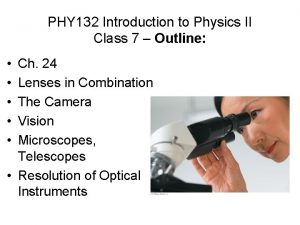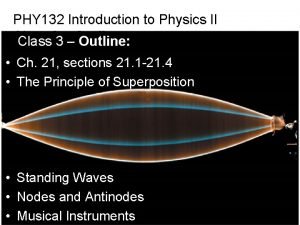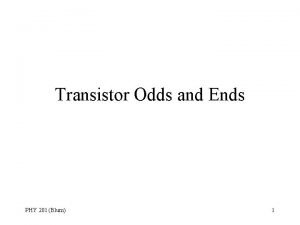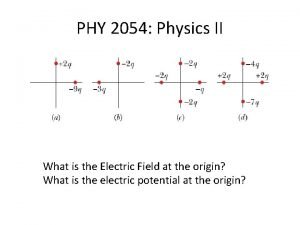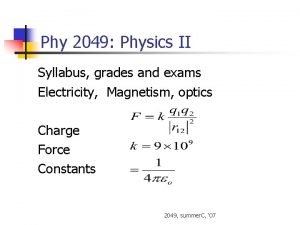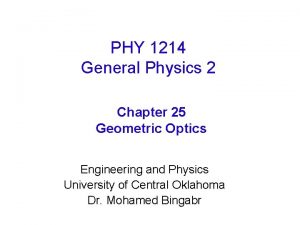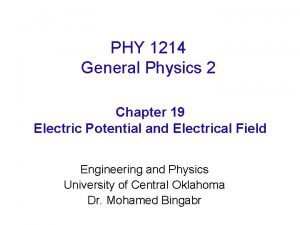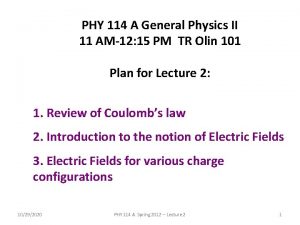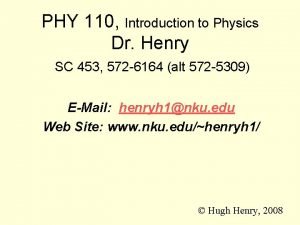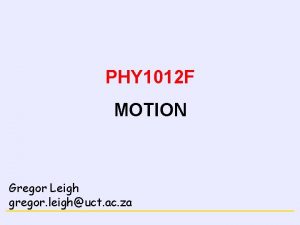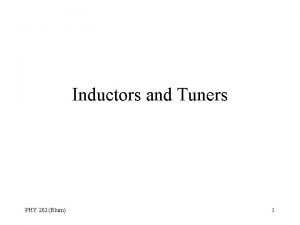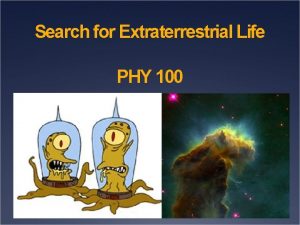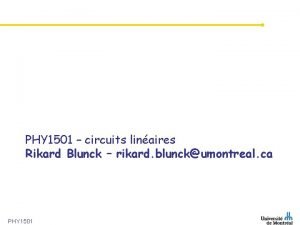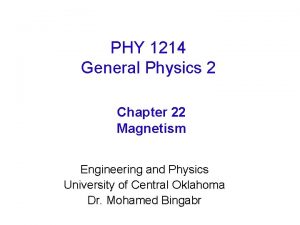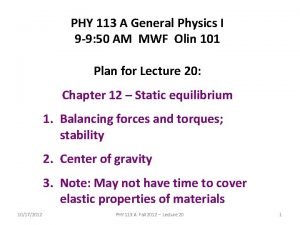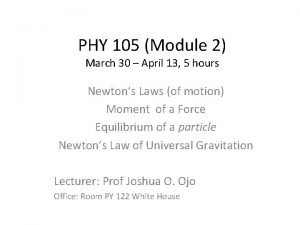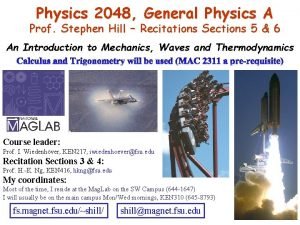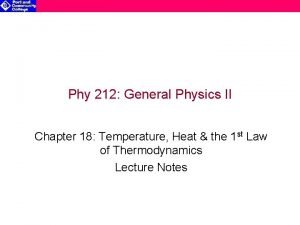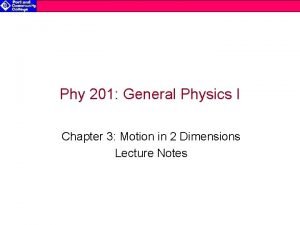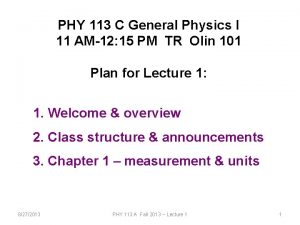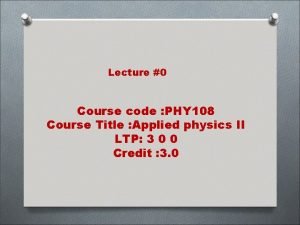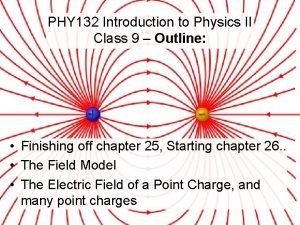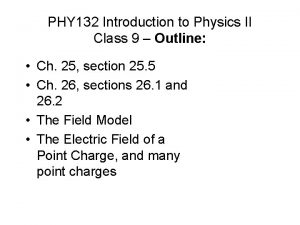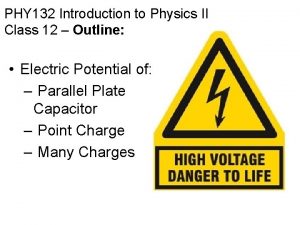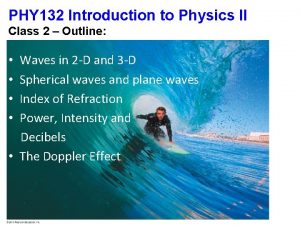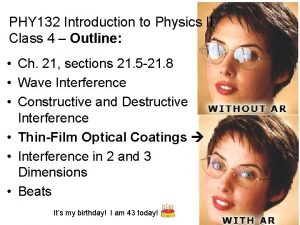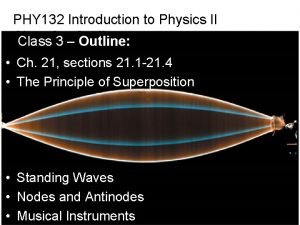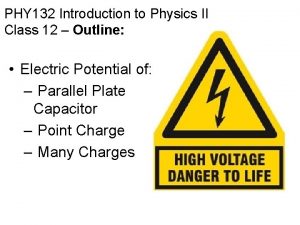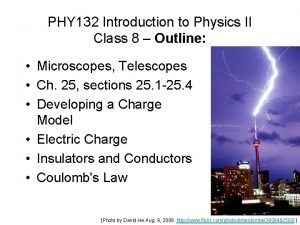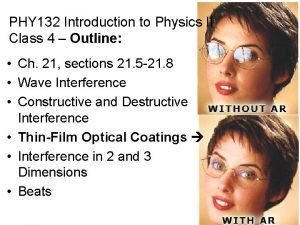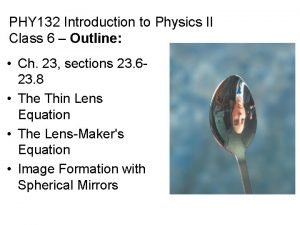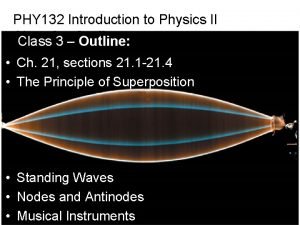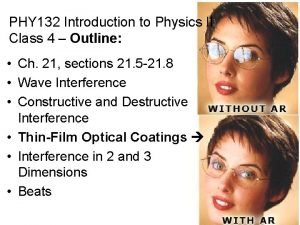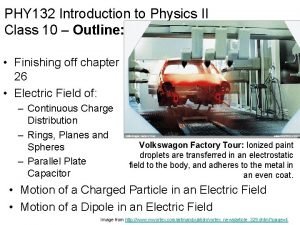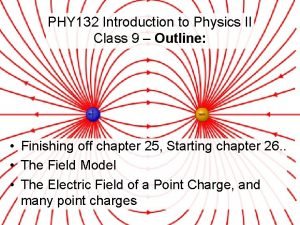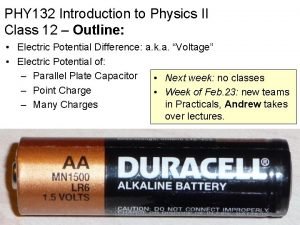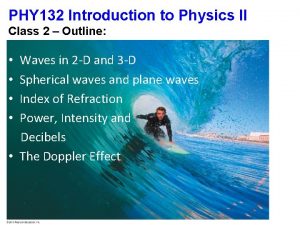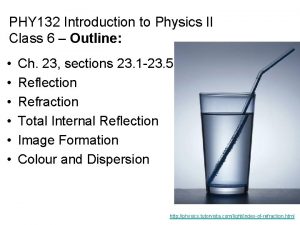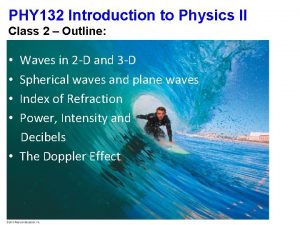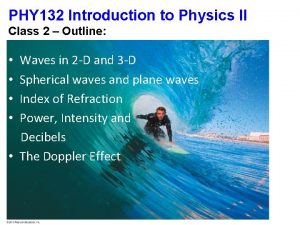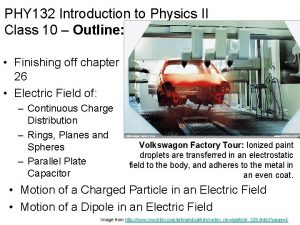PHY 132 Introduction to Physics II Class 11




































- Slides: 36

PHY 132 Introduction to Physics II Class 11 – Outline: • Finishing Chapter 26 on dipoles. . • Electric Potential Energy of: – Point Charges – Dipoles • Electric Potential: V • Voltage: ΔV

Quick. Check 26. 13 Which dipole experiences no net force in the electric field? A. Dipole A. B. Dipole B. C. Dipole C. D. Both dipoles A and C. E. All three dipoles. C.

Dipoles in a Uniform Electric Field § The figure shows an electric dipole placed in a uniform external electric field. § The net force on the dipole is zero. § The electric field exerts a torque on the dipole which causes it to rotate.

Dipoles in a Uniform Electric Field

Quick. Check 26. 14 Which dipole experiences no net torque in the electric field? A. Dipole A. B. Dipole B. C. Dipole C. D. Both dipoles A and C. E. All three dipoles. C.

Dipoles in a Uniform Electric Field § The figure shows a sample of permanent dipoles, such as water molecules, in an external electric field. § All the dipoles rotate until they are aligned with the electric field. § This is the mechanism by which the sample becomes polarized.

The Torque on a Dipole The torque on a dipole placed in a uniform external electric field is

Dipoles in a Nonuniform Electric Field § Suppose that a dipole is placed in a nonuniform electric field, such as the field of a positive point charge. § The first response of the dipole is to rotate until it is aligned with the field. § Once the dipole is aligned, the leftward attractive force on its negative end is slightly stronger than the rightward repulsive force on its positive end. § This causes a net force to the left, toward the point charge.

Dipoles in a Nonuniform Electric Field § A dipole near a negative point charge is also attracted toward the point charge. § The net force on a dipole is toward the direction of the strongest field. § Because field strength increases as you get closer to any finite-sized charged object, we can conclude that a dipole will experience a net force toward any charged object.

What is Potential Energy? A. mgh B. When an object has the potential to speed up. C. Voltage D. ½ k(Δx)2

Class 11 Preclass Quiz on Mastering. Physics § 74% got: Two positive charges are equal. Charge A has more electric potential energy. Both of these charges have the potential to accelerate toward the negative plate, speeding up.

Class 11 Preclass Quiz on Mastering. Physics § 70% of students got: The electric potential energy of a system of two point charges is proportional to the inverse of the distance between the two charges.

Class 11 Preclass Quiz on Mastering. Physics § 49% of students got: A positive and a negative charge are released from rest in vacuum. They move toward each other. As they do a negative potential energy becomes more negative.

Class 11 Preclass Quiz on Mastering. Physics § 56% of students got: “Dipole d has the smallest potential energy because it is aligned with the electric field. The greater the angle between the positive to the direction of the electric field, the greater the electric potential. ”

Class 11 Preclass Quiz – Student Comments… § “If charged particle moves perpendicular to the electric field direction, does its potential not change then? ” § Harlow answer: Correct. If the charge moves perpendicular to the electric field, then the electric force does zero work and the electric potential energy is unchanged. § “for the equation of electric potential energy in a uniform field, is the Uo always zero? ” Uelec = U 0 + q. Es § Harlow answer: No! U 0 is arbitrary. You choose a convenient value of s where U 0 = 0. (similar to the zero-point in gravitational potential energy. )

Class 11 Preclass Quiz – Student Comments… § “What is the name of Sherlock Ohms' assistant. . . Dr. WATTSon!” § “Q: What would you call a power failure? § A: A current event. ”

Energy § The kinetic energy of a system, K, is the sum of the kinetic energies Ki 1/2 mivi 2 of all the particles in the system. § The potential energy of a system, U, is the interaction energy of the system. § The change in potential energy, U, is 1 times the work done by the interaction forces: § If all of the forces involved are conservative forces (such as gravity or the electric force) then the total energy K U is conserved; it cannot be created or destroyed.

Work Done by a Constant Force § Recall that the work done by a constant force depends on the angle between the force F and the displacement r. § If 0 , then W F r. § If 90 , then W 0. § If 180 , then W F r.

Work If the force is not constant or the displacement is not along a linear path, we can calculate the work by dividing the path into many small segments.

Electric Potential Energy in a Uniform Field § A positive charge q inside a capacitor speeds up as it “falls” toward the negative plate. § There is a constant force F q. E in the direction of the displacement. § The work done is: Welec q. Esi q. Esf § The change in electric potential energy is: ΔUelec Welec where Uelec U 0 q. Es

Electric Potential Energy in a Uniform Field A positively charged particle gains kinetic energy as it moves in the direction of decreasing potential energy.

Electric Potential Energy in a Uniform Field A negatively charged particle gains kinetic energy as it moves in the direction of decreasing potential energy.

Electric Potential Energy in a Uniform Field § The figure shows the energy diagram for a positively charged particle in a uniform electric field. § The potential energy increases linearly with distance, but the total mechanical energy Emech is fixed.

Quick. Check 28. 4 A positive charge moves as shown. Its kinetic energy A. Increases. B. Remains constant. C. Decreases.

The Potential Energy of Two Point Charges § Consider two like charges q 1 and q 2. § The electric field of q 1 pushes q 2 as it moves from xi to xf. § The work done is: § The change in electric potential energy of the system is Uelec Welec if:

The Potential Energy of Two Point Charges Consider two point charges, q 1 and q 2, separated by a The Potential Energy of Point Charges distance r. The electric potential energy is • • This is explicitly the energy of the system, not the energy of just q 1 or q 2. Note that the potential energy of two charged particles approaches zero as r .

The Potential Energy of Two Point Charges § Two like charges approach each other. § Their total energy is Emech 0. § They gradually slow down until the distance separating them is rmin. § This is the distance of closest approach.

The Potential Energy of Two Point Charges § Two opposite charges are shot apart from one another with equal and opposite momenta. § Their total energy is Emech 0. § They gradually slow down until the distance separating them is rmax. § This is their maximum separation.

The Potential Energy of Multiple Point Charges Consider more than two point charges, the potential energy is the sum of the potential energies due to all pairs of charges: where rij is the distance between qi and qj. The summation contains the i j restriction to ensure that each pair of charges is counted only once.

Problem 28. 37 The four 1. 0 g spheres shown in the figure are released simultaneously and allowed to move away from each other. What is the speed of each sphere when they are very far apart?


The Potential Energy of a Dipole § Consider a dipole in a uniform electric field. § The forces F and F exert a torque on the dipole. § The work done is: § The change in electric potential energy of the system is ΔUelec Welec if:

The Potential Energy of a Dipole § The potential energy of a dipole is 0 minimum at where the dipole is aligned with the electric field. § A frictionless dipole with mechanical energy Emech will oscillate back and forth between turning points on either side of 0.

The Electric Potential § We define the electric potential V (or, for brevity, just the potential) as § This is NOT the same as electric potential energy. (different units, for one thing). § The unit of electric potential is the joule per coulomb, which is called the volt V:

Quick. Check 28. 6 A proton is released from rest at the dot. Afterward, the proton A. Remains at the dot. B. Moves upward with steady speed. C. Moves upward with an increasing speed. D. Moves downward with a steady speed. E. Moves downward with an increasing speed.

Before Class 12 on Wednesday (my last class…) • Please finish reading Knight Ch. 28 • Please do the short pre-class quiz on Mastering. Physics by tomorrow night. • Something to think about. A battery is designed to supply a steady amount of which of the following quantities? – Energy (Hint: only one of these is correct!) – Power – Electric potential difference – Electric current
 Phy 132 lecture 10: ch30
Phy 132 lecture 10: ch30 Phy 132
Phy 132 Phy 131 past papers
Phy 131 past papers Pa msu
Pa msu The great orthogonality theorem
The great orthogonality theorem Rotational statics
Rotational statics Phy theorem
Phy theorem Phy 113 past questions and answers
Phy 113 past questions and answers Phy 131 asu
Phy 131 asu Ddr phy architecture
Ddr phy architecture Phy 205
Phy 205 Eye accommodation
Eye accommodation Phy 2049
Phy 2049 Phy
Phy Phy
Phy Phy
Phy Atm packet phy
Atm packet phy Fizik ii
Fizik ii Phy 2049
Phy 2049 Real image
Real image Phy 1214
Phy 1214 Phy
Phy Law of motion
Law of motion Phy
Phy Phy
Phy Life phy
Life phy Phy1501
Phy1501 General physics
General physics 2012 phy
2012 phy Phy-105 5 discussion
Phy-105 5 discussion Phy 2048c fsu
Phy 2048c fsu Phy 212
Phy 212 Phy 1214
Phy 1214 Phy 1214
Phy 1214 Phy 1214
Phy 1214 Phy108
Phy108 Phy tgen
Phy tgen
